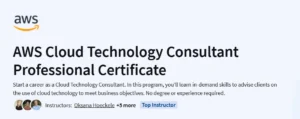What will you learn in Cloud Computing Fundamentals Course
Grasp fundamental cloud computing concepts, including virtualization, multitenancy, and clustering
Differentiate between service models (IaaS, PaaS, SaaS) and core cloud services across major providers
Understand storage options (object, block, file) and deployment strategies in the cloud
Evaluate and select a cloud platform (AWS, Azure, GCP) based on business requirements
Gain hands-on experience with platform setup, service exploration, and service-model mapping
Program Overview
Module 1: Introduction to Cloud Computing
⏳ 30 minutes
Topics: Virtualization, cloud history, essential characteristics (on-demand self-service, broad network access)
Hands-on: Launch your Educative IDE and explore the course sample dataset
Module 2: Core Cloud Service Models
⏳ 1 hour
Topics: Infrastructure as a Service (IaaS), Platform as a Service (PaaS), Software as a Service (SaaS)
Hands-on: Classify 10 services from AWS, Azure, and GCP into IaaS/PaaS/SaaS categories
Module 3: Cloud Clustering & Compute
⏳ 45 minutes
Topics: Clustering fundamentals, elasticity, scaling strategies (vertical vs. horizontal)
Hands-on: Simulate cluster scaling by adjusting node counts in a mock environment
Module 4: Storage Options & Patterns
⏳ 45 minutes
Topics: Object storage (S3), block storage (EBS/Azure Disk), file storage (EFS/Azure File)
Hands-on: Map three real-world use cases to the optimal storage type
Module 5: Deployment & Automation
⏳ 45 minutes
Topics: Deployment models (public, private, hybrid), CI/CD pipelines, Infrastructure as Code
Hands-on: Write a simple deployment script using IaC principles for a sample web app
Module 6: Platform Selection & Next Steps
⏳ 30 minutes
Topics: Evaluating cost, compliance, regional availability, managed services
Hands-on: Provision a free-tier account on AWS/Azure/GCP and navigate the console
Get certificate
Job Outlook
United States: Cloud Engineers earn an average of $131,376 USD per year
Global Median: Approximately $126,100 USD annually
Demand driven by enterprises migrating workloads to cloud and adopting microservices
Roles include Cloud Engineer, Solutions Architect, DevOps Engineer, and Cloud Consultant
Specification: Cloud Computing Fundamentals
|





